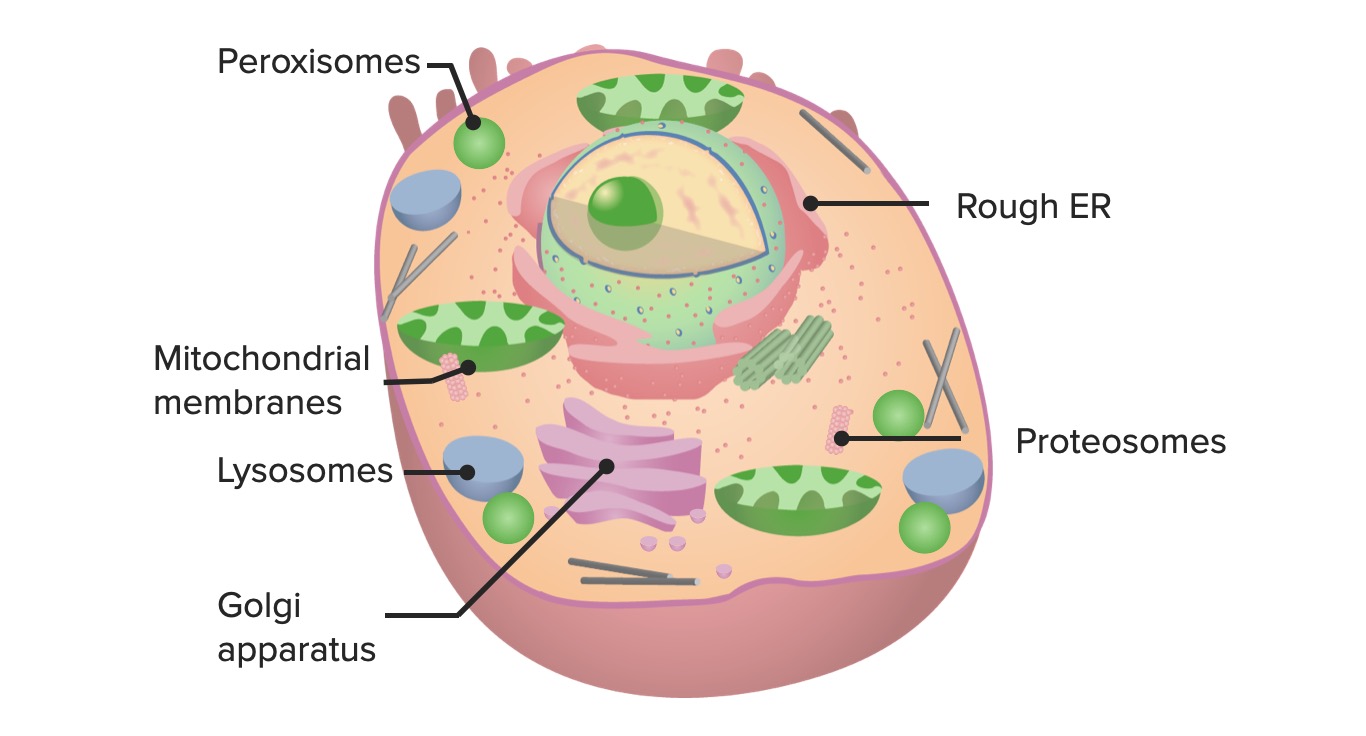Playlist
Show Playlist
Hide Playlist
Cell Membranes & Organelle Membranes
-
Slides GP Membrane Physiology.pdf
-
Download Lecture Overview
00:01 Okay, let's talk about partitioning and why we want to have membrane structures within the cell. 00:08 So, cell membrane and other membranes within the cell. 00:13 Let's first start by talking about the cell membrane, because this is probably the most important. 00:17 Because it separates inside the cell from outside the cell. 00:20 And why this is so important if we talked about homeostasis and maintaining the internal environment within the cell, we need to have some sort of separation mechanism to keep that inside and separate that from outside. 00:37 However, each portion of the cell or its organelles will have various membranes associated with them. 00:43 The endoplasmic reticulum is one. 00:45 And in this endoplasmic reticulum, which could be rough or smooth, is oftentimes where protein synthesis is taking place. 00:52 This is also where you could be packaging some of the cell secretions that may occur. 00:57 The Golgi complex is kind of an extension of the endoplasmic reticulum where further processing takes place. 01:05 And eventually you'll get some budding of various vesicles. 01:08 And that will be what our secretion mechanisms will be. 01:12 We also have various smaller cellular structures such as lysosomes, and peroxisomes. 01:18 These are located close to the cell membrane just on the inside. 01:23 Lysosomes are complex organelles and perform multiple functions, including enzymatic digesting organic material such as endocytosed bacteria and worn -out cell components by using more than 60 hydrophilic enzymes. 01:37 They also perform cell membrane repairs and are important in nutrient sensing, metabolic adaptation, organellar crosstalk, and aging. 01:45 The interior is kept acidic at a pH of approximately 5, which is a safety feature for the cell because if the lysosomes were to break open and release their contents, the enzymes would not be efficient at the near neutral cytosolic of pH 7.2. 02:01 Peroxisomes are also complex organelles that are involved in the biosynthesis of membrane phospholipids, fatty acid β-oxidation, photorespiration, and the synthesis of signaling molecules. 02:14 Peroxisomes also have roles in stress responses, reactive oxygen species metabolism, üand appear to play a role in immunity. 02:22 The mitochondrial membrane is the final kind of organelle structure membrane that we'll talk about. 02:29 It's a little bit more specialized. 02:31 In fact, it has a dual membrane structure. 02:33 And so the first portion of the membrane allows for some things to move in and out. 02:38 But then you have a second membrane structure that is more well separate the structures to a little bit greater degree. 02:46 And this will be important for such things as oxidative phosphorylation and production of energy within the cell. 02:54 The nuclear envelope is another kind of partition that we have. 02:58 It is not exactly like the other cell membrane structures. 03:02 It has some larger pores in it that allow for some molecules to move in and out. 03:06 And that is helpful for signaling and trafficking. 03:12 The final thing that we have is a vesicle membrane. 03:15 And these vesicles usually are butted off from things like the Golgi apparatus, and will eventually dock and fuse into the cell membrane spilling its contents out into the extracellular environment. 03:30 Okay, so now let's talk a little bit about, Why in the world do you have partitions anyway? And I think the best way to think about why partitioning things within a cell is think about your own apartment or your own house. 03:42 Why do you have walls within your particular apartment or house? And why would that be important? Or how is that sometimes helpful? So why have these partitions? Well, I think this basically occurs often when you want to do a specific task within a certain room. 04:01 For example, cooking. 04:02 Sometimes it's advantageous to cook within one room and keep that separate from the rest of the house. 04:08 Maybe you're making something that has a certain aroma or smell to it that you want to keep within that room. 04:14 Or maybe you have certain tasks that you want to do at other parts of the house or apartment such as sleeping. 04:20 But yet you have an apartment mate, or you have another person that's living with you. 04:25 That person is not ready to go to bed yet. 04:28 So by partitioning out that it's easier to have one function occurring such as sleeping. 04:35 So how are these particular partitions constructed? Well, you're going to have an inner wall and outer walls. 04:42 And as you know, usually you have thicker outer walls, then you will have inner walls. 04:48 But what are these particular membranes made of? So we'll spend a couple of minutes talking about, How they're specifically made up? What their sizes are? And how that structure affects its function?
About the Lecture
The lecture Cell Membranes & Organelle Membranes by Thad Wilson, PhD is from the course Membrane Physiology.
Included Quiz Questions
What is the endoplasmic reticulum?
- The place where proteins are synthesized and secretions are packaged
- The energy storing place for the cell
- The place where substances are digested and recycled
- The place where the coding information is stored
- The place where hormones bind
Where in the cell are lysosomes located?
- Just on the inside of the cell membrane
- In the nucleus
- In the Golgi apparatus
- In the mitochondria
- In peroxisomes
Which of the following is TRUE regarding cellular vesicles?
- They are processed via lysosomes, the Golgi apparatus, and endoplasmic reticulum.
- They originate from within the mitochondria.
- The inner material of a vesicles exactly matches that of the cytosol.
- They terminate within the cellular nucleus to produce genetic changes in transcription or translation.
- They have a carbohydrate-rich exoskeleton that allows them to travel to distant tissues to effect their cellular responses.
Customer reviews
5,0 of 5 stars
| 5 Stars |
|
1 |
| 4 Stars |
|
0 |
| 3 Stars |
|
0 |
| 2 Stars |
|
0 |
| 1 Star |
|
0 |
The way he explains was easily to understand and memorize. Thank you..




